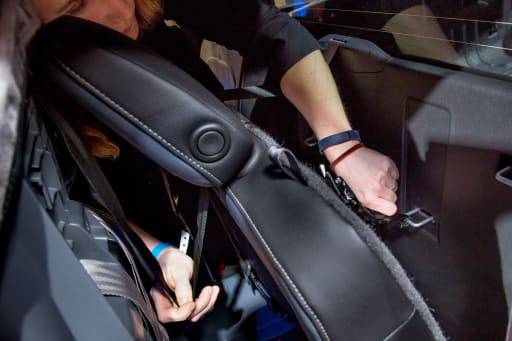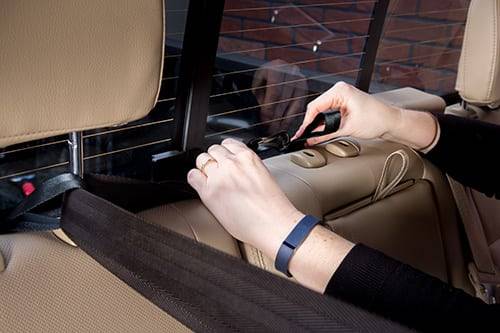Trucks' Tether Anchors Are Often Tricky to Find, Use


CARS.COM — Tether anchors, a critical part of a vehicle’s Latch system, often go unused by parents and caregivers. In sedans, where the tether anchors are easy to find on the rear shelf behind the head restraints, they’re used only 52 percent of the time, according to one study. In pickup trucks, where the anchors are difficult to locate, that number drops significantly.
Related: Five Things Families Should Look for in Pickup Trucks
In a 2014 study of tether anchor use and misuse conducted by the Insurance Institute for Highway Safety, it found that parent volunteers with car-seat-installation experience had the most problems correctly using the loop-style tether anchors found in some pickup trucks. These volunteers installed the tether strap correctly only 11 percent of the time in the trucks. In other cars, volunteers used the tether anchor correctly 57 percent of the time.
While many may not consider a pickup a family vehicle, the full-size versions make easy work of hauling three kids in car seats. To help truck-owning parents, caregivers and prospective parents, we’ve combed through owner’s manuals and crawled through pickup trucks to show the different styles of tether anchors and how to correctly use them.
We limited our fact-finding mission to models with rear seats. Before installing your child’s car seat, read the vehicle’s owner’s manual and the child seat’s owner’s manual to ensure you’re installing it correctly. If you’re unsure about your car-seat installation, take it to a certified car seat technician, who will inspect the installation for free and offer advice. Remember: It’s important to use the tether anchor with a forward-facing convertible or combination child seat because it helps to reduce a child’s head movement in a crash by 6 to 8 inches. After your child has outgrown the convertible car seat, they will move to a booster seat.
Pickup Truck Tether Locations

Behind the Rear Head Restraints
These tether anchors are small loops that are found under or behind the rear-seat head restraints. After installing a forward-facing car seat using the lower Latch anchors or a seat belt, parents need to raise or remove the head restraint and route the tether strap through the loop directly behind the car seat (keeping the tether loop behind the head restraint posts, if they’re in place). Then attach the tether hook to the adjacent seat’s tether loop. The tether strap should then be tightened.
Two or three forward-facing convertibles can be installed with the tether loop system, sharing a loop. In the 2015 Ram 1500 crew cab or Quad Cab, the owner’s manual says to install the outboard car seats first. The tether straps are inserted through the loops behind each car seat and attached to the center position’s tether loop, but not tightened. Then the center car seat is installed in the middle passenger seat with the tether strap routed first through the center loop and then attached to an outboard seat’s loop; Ram doesn’t specify which loop to use, but some automakers do. Parents should then tighten the outboard car seats’ tether straps first, then the center car seat’s tether.
Trucks With This Setup
- 2015 Chevrolet Colorado extended cab
- 2015 Chevrolet Silverado 1500 crew or double cab
- 2015 Ford F-150 SuperCab or SuperCrew cab
- 2015 GMC Canyon extended cab with rear seats
- 2015 GMC Sierra crew and double cab
- 2015 Ram 1500 Quad and crew cab
- 2015 Toyota Tundra double cab and CrewMax
Behind the Rear Seatbacks
These tether anchors are out of sight, which often means out of mind for many parents. The hidden location also adds a level of difficulty when installing car seats. Unlike the tether loops, parents don’t need to route the tether strap through anything when using this anchor. Simply connect to the anchor behind the car seat’s location.
To use the tether anchor, parents will need to connect the tether strap to the anchor before installing the car seat with the lower Latch anchors. The 2015 Chevrolet Colorado crew cab has this setup; in its owner’s manual, it says to first fold the rear seatback to access the tether anchor behind it. On the car seat, adjust the tether strap to its full length and attach the hook to the tether anchor. Next, lock the seatback in place and make sure it’s secure. Now, parents can install the car seat into the seat with the lower Latch anchors or a seat belt and then tighten the tether anchor. Lastly, parents should check the overall installation by tugging at the belt path to make sure the car seat doesn’t move more than an inch.
It sounds relatively simple, but we ran into problems with these instructions with one of our convertible car seats because its tether strap’s tightening mechanism sat near the tether hook. After attaching the hook to the tether anchor and locking the seatback into place, we couldn’t tighten the anchor at all. Instead we folded the seatback forward again and tightened the tether strap. We’d then lock the seatback in place and check to see if the tether was tight enough. It took several attempts to get it right.
Trucks With This Setup
- 2015 Chevrolet Colorado crew cab
- 2015 GMC Canyon crew cab
- 2015 Toyota Tacoma double cab
- 2015 Nissan Frontier crew cab
- 2015 Nissan Titan
On the Side of the Rear Seats
This position combines the problems of the two other tether locations: additional steps and unusual locations. Thankfully, only a few pickups have this setup. The outboard rear truck seats each have a tether anchor on their sides closest to the doors.
In the 2015 Toyota Tacoma Access Cab with rear seats (photo above), first remove the tether anchor and tether routing device covers. Install the car seat using the lower Latch anchors or seat belt and then route the tether strap through the routing anchor, which is found at the top of the seatback. Then connect the tether hook to the tether anchor on the side of the seat and tighten the tether strap.
Trucks With This Setup
Cars.com photos by Evan Sears; manufacturer image
Cars.com’s Editorial department is your source for automotive news and reviews. In line with Cars.com’s long-standing ethics policy, editors and reviewers don’t accept gifts or free trips from automakers. The Editorial department is independent of Cars.com’s advertising, sales and sponsored content departments.

Editor-in-Chief Jennifer Newman is a journalist with more than 25 years of experience, including 15 years as an automotive journalist at Cars.com. Jennifer leads the Editorial team in its mission of helping car shoppers find the vehicle that best fits their life. A mom of two, she’s graduated from kids in car seats to teens behind the steering wheel. She’s also a certified car-seat technician with more than 12 years of experience, as well as member of the World Car Jury, Automotive Press Association and Midwest Automotive Media Association. LinkedIn: https://www.linkedin.com/in/jennilnewman/ Instagram: @jennilnewman
Featured stories




